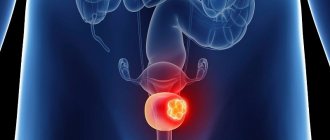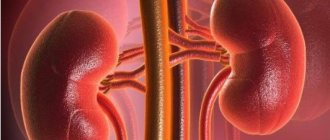Interstitial cystitis is a chronic inflammatory process of the bladder.
It is one of the four most common causes of pelvic pain.
In recent years, this term has been gradually replaced by another: painful bladder syndrome.
Causes of interstitial cystitis
The origin of the disease remains unclear.
In 90% of cases, women are affected.
But sometimes the disease affects men too.
Average age of patients: 45 years.
Main theories about the causes of interstitial cystitis:
- autoimmune inflammatory reactions;
- increased content of mast cells in the mucosa;
- violation of the integrity of the epithelium as a result of infection;
- increasing the permeability of the mucosal barrier to toxins from urine;
- impaired blood circulation in the wall of the organ;
- neurogenic theory (the “phantom pain” effect);
- estrogen deficiency.
Different theories contradict each other.
None can fully explain all cases of the disease.
The inflammatory theory is one of the key ones.
At the same time, the disease does not always occur with obvious clinical and morphological signs of inflammation.
Hunner's ulcers characteristic of the disease may be absent.
The autoimmune theory is based on pathological changes in the state of immunity in most patients.
In addition, the disease is very often combined with rheumatoid arthritis, thyroiditis and systemic lupus erythematosus.
Symptoms of interstitial cystitis
Main clinical manifestations of the disease:
- pain over the womb;
- frequent urination;
- strong urges;
- night urination 2 times a night or more often.
The pathology has nothing to do with infectious inflammation.
With interstitial cystitis, the urine remains sterile.
The main symptom is pain.
It intensifies when the bladder is full and weakens after it is emptied.
The pain does not go away immediately, but a few minutes after going to the toilet.
The pain is worse in postmenopausal women.
For many, frequent urination is not due to the urge, but to the desire to get rid of pain.
In 50% of cases, pain occurs during sexual intercourse.
Possible complications
Constant inflammation and damage to the bladder mucosa lead to the following complications:
- With a long course of the disease, the maximum capacity of the bladder decreases and the elasticity of its walls decreases. A shriveled bladder is formed due to the replacement of healthy tissue with scar tissue.
- Salt deposition and the formation of stones in the bladder due to disruption of the natural process of urination.
- Development of renal failure due to an increased risk of impaired renal filtration function.
- A gradual decrease in quality of life and loss of social roles due to constant severe pain and frequent urination.
- Painful sexual intercourse and related sexual and marital problems.
- Chronic stress and the development of clinical depression due to constant pain and disrupted sleep.
Interstitial cystitis: diagnosis
In many ways, interstitial cystitis is a diagnosis of exclusion.
It is placed in cases where a woman has been examined up and down, but no other causes for the symptoms have been found.
The diagnosis of interstitial cystitis will NOT be established in the following cases:
- bladder capacity over 0.35 l;
- duration of symptoms is less than six months;
- predominance of nighttime diuresis over daytime;
- less than 8 urinations per day;
- relief of the condition when taking antispasmodics;
- bacterial cystitis suffered in the last 3 months;
- urolithiasis disease;
- chronic infections: herpes, tuberculosis;
- oncological diseases;
- taking cyclophosphamide;
- radiation therapy;
- chemical burns or bladder diverticula;
- age up to 18 years.
The absence of interstitial cystitis is supported by imperative urges that occur after quickly filling the bladder with at least 100 ml of gas or 150 ml of liquid.
And also the presence of contractions of the bladder muscles during the process of filling it.
For all these conditions, other diagnoses are established.
If nothing is found, interstitial cystitis can be diagnosed.
This diagnosis is indicated by three main criteria:
- pain over the womb;
- strong, uncontrollable urge to empty the bladder;
- Cystoscopy findings: Hunner's ulcers or glomerulation.
Treatment of interstitial cystitis
Treatment options are limited.
A huge number of different methods are used.
But the disease cannot be cured; the procedures and medications used are aimed only at alleviating symptoms.
The American Urological Association recommends a stepwise algorithm for the treatment of interstitial cystitis.
Stage 1:
- reduced salt intake;
- limiting alcohol, coffee, spicy seasonings, soda;
- to give up smoking;
- consumption of 2 liters of water per day;
- massage;
- psychotherapy;
- antidepressants;
- antihistamines.
At stage 2, intravesical pharmacotherapy is carried out.
Different countries have different approaches to choosing drugs.
In Europe, preference is given to medications that restore the protective layer of the bladder.
Sodium hyaluronate is used, less often chondroitin sulfate.
Names of drugs:
- Uro-Gial;
- Urocyst;
- Cystistat.
The protective layer of the urea consists of glycosaminoglycans (GAG layer).
They are found in high concentrations under the epithelium.
These substances protect the bladder from irritation by urine, in which quite aggressive substances may be dissolved.
Hyaluronic acid protects the inner walls of the bladder from irritation.
In addition, it has antioxidant properties and stimulates the immune system.
At the same time, in the United States, preference is given to other drugs.
Topically used:
- heparin;
- lidocaine;
- glucocorticoids;
- dimethyl sulfoxide.
At the 3rd stage of treatment, hydrobougation of the bladder is performed.
This procedure is performed under general anesthesia.
It is performed during cystoscopy.
The doctor carefully examines the cavity of the bladder.
If he detects Hunner's ulcers, he carries them out:
- excision;
- coagulation;
- laser vaporization;
- or administration of triamcinolone into the submucosal layer.
The method of dealing with ulcers depends on their size and location.
Stage 4 of treatment includes the use of BCG.
The method has no proven effectiveness.
Research data is contradictory.
However, BCG is used in many clinics.
Other treatments:
- sacral neuromodulation;
- bladder plastic;
- supravesical diversion of urine;
- cystectomy.
Radical treatment is indicated only for lost bladder capacity and severe pelvic pain.
Histopathological picture
The purpose of a microscopic examination of a biopsy of the bladder mucosa is to exclude intraepithelial bladder cancer and tuberculous cystitis. There may be no changes in the microscopic image of interstitial cystitis, but most often the urothelial epithelium becomes thinner and hemorrhagic foci are visible underneath.
Microscopic image of interstitial cystitis
There is swelling or fibrosis of the lamina propria, an increase in the capillary blood vessels located under the epithelium, the wall of which is thickened. In later stages, fibrotic changes appear within the muscularis propria (sometimes leading to fibrosis).
Within the lamina propria and within the muscle tissue there are lymphocytic infiltrates, plasma cells, eosinophils and mast cell infiltrates. The presence of the latter is an important diagnostic criterion. Demonstration of 20 mast cells per 1 mm2 is a factor confirming the diagnosis of IC, and may be a marker of this disease.
A characteristic feature is also infiltration around the nerve fibers in the wall of the bladder. In the most severe form, Hanner's ulcer, the absence of epithelium is visible, and the infiltration of inflammatory cells covers all layers of the bladder wall (pancystitis). Deposition of immunoglobulin IgA particles in the mucosa and submucosa has been reported, and the presence of Tamm-Horsfall glycoprotein deposits in the mucosa has been demonstrated in some cases of interstitial cystitis.
A histopathological pattern similar to IC can be found in bladder mucosal ulcers and during healing, such as after biopsy.
Drugs for the treatment of interstitial cystitis
All medications used for interstitial cystitis are divided into three groups.
1. Drugs that directly or indirectly affect the activity of the nervous system.
These include:
- narcotic analgesics;
- non-steroidal anti-inflammatory drugs;
- local antiseptics;
- antidepressants;
- antihistamines;
- antispasmodics.
2. Drugs that provide cyst-destructive action (destruction of umbrella cells).
These are dimethyl sulfoxide, silver nitrate, chloropactin.
3. Drugs that provide a cystoprotective effect (protecting the bladder from the effects of urine).
These are products that restore the mucin layer.
These include hyaluronate, pentosan polysulfate, heparin.
Many other medications are also used.
Not all methods have proven effectiveness.
Let's consider individual drugs and groups of drugs that are used for interstitial cystitis.
Antihistamines
This includes antiallergy medications.
As well as medications that are usually used to reduce the secretory activity of the stomach.
According to their mechanism of action, they are blockers of H2-histamine receptors.
We looked at theories of the origin of interstitial cystitis.
Among others, the role of mast cells was mentioned.
It was in connection with this theory that the use of antihistamines began.
Research shows that they do reduce symptoms.
However, it remains unclear why this happens.
Since a biopsy of the bladder mucosa before and after treatment shows that there are no morphological changes in it.
However, histamine provokes:
- pain;
- vasodilation;
- redness of the mucous membrane.
Therefore, the prescription of drugs is considered justified.
Cimetidine is most often used.
It is prescribed 0.4 g, 2 times a day, orally.
The drug reduces the severity of pain over the pubis and the frequency of the urge to urinate at night.
Hydroxyzine – rarely used, data on effectiveness are conflicting.
Antidepressants
Patients with interstitial cystitis are prescribed amitriptyline.
It has antihistamine and sedative activity.
It is also a serotonin and norepinephrine reuptake inhibitor.
The drug is used for a long time.
The good thing about it is that the effect persists even after the end of the therapeutic course.
The drug reduces pain and improves the psycho-emotional state of patients.
Pentosan polysulfate
Sometimes used to correct defects in the GAG layer.
It is taken orally, 100 mg per day.
Treatment lasts from 4 months.
Some studies show that during this time, symptoms are reduced by the drug in 50% of patients.
Further clinical trials showed that increasing the dose to 300 mg per day did not lead to an increase in the effectiveness of PPS.
The drug is combined with antihistamines.
However, some studies have shown no effect of pentosan polysulfate compared to placebo.
The effectiveness of the drug is not considered proven.
Therefore, it is rarely prescribed.
Intravesical therapy
Hydrobougation of the bladder is used to treat interstitial cystitis.
Various drugs are also administered orally through a catheter.
Hydrobouging
This is the process of stretching it by pumping liquid inside.
The procedure is performed under general anesthesia.
Mechanisms of action:
- deterioration of blood circulation in the bladder wall and resulting necrosis of sensory nerve endings;
- increased levels of heparin-binding growth factor;
- change in vascularization.
Research shows that the positive effect of the procedure lasts quite a long time.
But gradually it decreases.
After 6 months, the effect persists only in every third patient.
After 1 year – every fifth person.
Better results are obtained in situations where the initial capacity of the bladder exceeds 150 ml.
Dimethyl sulfoxide
The drug increases the permeability of biological membranes.
It increases the effectiveness of other drugs.
In addition, it relieves inflammation and reduces pain.
The drug reduces the release of histamine by mast cells and relaxes the bladder muscles.
For the vast majority of patients, symptoms go away after using dimethyl sulfoxide.
But after some time they return.
Relapses occur in 40-60% of patients.
Heparin can be used to reduce its risk.
Heparin
One study showed that the drug reduces the risk of relapse by 2.5 times.
It is assumed that the action of heparin is based on the fact that it:
- is an analogue of the mucopolysaccharide layer and strengthens the mucous membrane;
- inhibits the formation of new blood vessels;
- relieves inflammation;
- slows down fibroblast proliferation.
Heparin is administered three times a week for a course of 3 months.
Moreover, in 50% of patients receiving such therapy, remission remains for 1 year or more.
For 30% - from 6 to 12 months.
Only 20% relapse within less than 6 months.
You can improve results by using additional drugs:
- hydrocortisone;
- oxybutynin;
- tolterodine.
BCG
The BCG vaccine is used for immunotherapy.
It has been successfully used for bladder cancer.
In this regard, it has been suggested that BCG is also suitable for the treatment of interstitial cystitis.
Some studies have shown that the vaccine does have some results and helps achieve remission.
But other trials have demonstrated the ineffectiveness of this approach to treating interstitial cystitis.
Moreover, they have a higher level of reliability.
Therefore, BCG is not currently recommended for use in such cases.
Hyaluronic acid
It is a component of the GAG layer.
Protects the bladder wall, normalizes the activity of the immune system and neutralizes free radicals.
The drug is non-toxic.
The effect after a course of therapy lasts for an average of 4-5 months.
The course usually involves the injection of hyaluronate into the bladder once a week for 1 month.
Long-term treatment is also possible.
In some studies, patients received therapy for up to 37 months (more than 3 years).
This allowed them to maintain remission of the disease.
Chlorpactin
It is a derivative of hypochloric acid.
Its instillations are painful and are therefore performed under general anesthesia.
Not used for reflux of urine into the ureters.
Because it can cause fibrosis and the development of obstruction.
In 70% of patients, symptoms decrease for 6 months or more.
The main features of this disease are:
The predominance in the structure of cases is 4-6 times more likely to be female;
High frequency (about 50%) of relapse (return of symptoms), which in 90% of cases is associated with re-infection (reinfection);
In more than 95% of cases, acute cystitis is caused by a single microorganism;
The leading causative agents of acute cystitis are Escherichia coli (Escherichia coli) in 70-95% of cases and Staphylococcus aureus (Staphylococcus saprophyticus) in 5-20% of cases;
The entry of microorganisms into the bladder is NOT the main condition for the development of the inflammatory process;
The most common manifestations of the disease are: frequent painful urination and urgency (the need to immediately empty the bladder at the first urge to urinate);
The diagnosis is established on the basis of complaints and urine tests, which reveal leukocytes and microorganisms;
If the disease is typical and the source of infection is obvious, urine culture is not performed.
Spontaneous recovery within a month, without the use of antibiotics, is observed in 40% of people.
Successful treatment of acute cystitis is possible with the help of an antimicrobial agent that creates a high concentration in the urine and is effective against pathogens;
A low level of resistance of E. coli is observed to Nitrofurantoin, Cefuroxime, Cefotaxime, Amoxicillin/clavulanate.
The course of treatment for acute cystitis ranges from 3 (most optimally) to 7 days;
For people with frequently recurrent acute cystitis - more than 2 exacerbations within six months and more than 3 exacerbations within 1 year, preventive therapy is recommended.
Chronic bacterial cystitis is a disease that is divided into a number of different forms. So, it is customary to highlight:
Chronic latent cystitis:
- with a stable latent course - absence of complaints, laboratory (no changes in urine analysis) and bacteriological data (pathogen is not detected), the inflammatory process is detected only during endoscopic (examination with a cystoscope) examination;
- with rare exacerbations - activation of inflammation of the acute type, no more than once a year;
- with frequent exacerbations - exacerbation 2 times or more per year, such as acute and subacute cystitis.
Chronic cystitis itself (persistent) – positive laboratory and endoscopic data, persistent (constantly present) symptoms in the absence of a violation of the reservoir (accumulation of urine) function of the bladder (see page 1);
Interstitial cystitis is a persistent pain symptom complex, severe symptoms, impaired reservoir function of the bladder.
The main features of any form of chronic cystitis are:
Unfounded and irrational antibacterial therapy, leading to the formation of resistant bacterial species and disruption of immunoregulatory mechanisms, is most often the cause of the transformation (transition) of acute cystitis into chronic.
It is also possible to develop chronic cystitis after catheterization of the bladder, for example, after surgical interventions, to collect urine for analysis, which leads to the contamination of polymicrobial (several microorganisms) hospital microflora, which is difficult to treat.
Chronic cystitis can develop against the background of bladder tumors, central paresis (paralysis of the limbs), strictures (scar narrowing of the urinary tract), tuberculosis, or previous injuries.
A feature of this disease is the involvement of all three layers of the bladder wall in the inflammatory process, which leads to its thickening and, in some cases, to a significant decrease in the physiological capacity of the bladder.
Chronic cystitis in the acute phase manifests itself with the same symptoms as acute cystitis, i.e. frequent painful urination and urgency (see above);
Along with the symptoms of cystitis, symptoms of the underlying pathology may appear, causing the process to become chronic;
Diagnosis of chronic cystitis depends on the suspected cause of its development, and is often aimed at identifying it, which may require using the entire list of studies described for diagnosing bladder cancer;
Treatment of chronic cystitis is a difficult task, since the cause of its development is not always clear, and inadequate therapy worsens the course and prognosis of the disease;
Etiological treatment - antibacterial therapy, based on 3 principles: duration 7-10 days, choice of drug based on the antibiogram, use of antibiotics with a bactericidal effect;
The effectiveness of immunotherapy is described - the use of drugs (Uro-Vaxom, bacteriophages) that increase the local immunoregulatory mechanisms of the urinary tract.
Separately, let me briefly dwell on the description of interstitial cystitis, which is a variant of chronic cystitis, as mentioned above.
This form of cystitis deserves close attention for a number of reasons, since interstitial cystitis:
- It is one of the most common potential causes of chronic pelvic pain in the practice of a urologist;
- Considered the most controversial issue in modern urology;
- It is a diagnosis of exclusion because it does not have pathognomonic (specific only to this form) manifestations;
- It is a symptom complex, and not a specific disease, manifested by symptoms of bladder irritation (frequent urination, urgency, nocturia (the urge to urinate at night), dysuria) and pain in the bladder/pelvic area with normal bacteriological results (aimed at identifying the causative agent of the disease) ) urine tests;
- It can be caused by a variety of reasons, being, in fact, a universal reaction of the bladder to various paths of damage.
Prognosis for interstitial cystitis
Interstitial cystitis is a severe chronic disease that cannot be cured.
Its causes are unknown, the diagnosis is established only after excluding all other causes of pelvic pain.
There are currently no treatments that work for 100% of patients.
Data on the effectiveness of many drugs is conflicting.
The treatment regimen is selected individually.
The doctor's job is not to completely cure the patient.
Its actions are aimed at:
- reduction of symptoms;
- achieving remission;
- its long-term maintenance.
To date, there are no uniform algorithms for treating the disease.
Some patients are helped by some drugs, others by others.
Some clinics use certain schemes and methods, others use others.
The disease always progresses in waves.
From time to time, exacerbations occur when symptoms appear or intensify.
After treatment, remissions begin.
In the most favorable cases, they can last for years.
An unfavorable prognostic factor is a decrease in urea capacity.
There is a high probability that such a patient will require surgery in the future.
Diet therapy
Some studies have shown that in almost 90% of patients, an exacerbation of the disease is associated with taking certain foods. The list of “dangerous” products includes [1]:
- Coffee
- Alcohol
- Monosodium glutamate
- Tomatoes
- Vinegar
- Citrus
- Spicy food
- Chocolate
- Cranberry juice
Many experts recommend either avoiding the consumption of triggers altogether, or introducing them into the diet occasionally. In order to reflect the connection between the introduction of various foods into food and the exacerbation of IC symptoms, it is advisable to keep a food diary. Next, we will consider how to treat interstitial cystitis.







